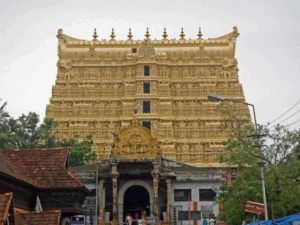Published on: June 11, 2025
PADMANABHASWAMY TEMPLE IN THIRUVANANTHAPURAM
PADMANABHASWAMY TEMPLE IN THIRUVANANTHAPURAM
CONTEXT
- A rare Maha Kumbhabhishekam ritual was recently conducted after 270 years at the Sree Padmanabhaswamy Temple in Thiruvananthapuram, Kerala.
- The ritual involves a ceremonial purification and reconsecration of the temple, attended by lakhs of devotees.
- It marks a spiritually significant event reviving age-old temple traditions and royal customs.
CONCEPT
Historical Significance
- Dedicated to Lord Vishnu, referred to here as Padmanabhaswamy, depicted in Anantha Shayanam (eternal yogic sleep) posture on Adishesha (serpent).
- The earliest reference dates back to the 8th–9th century CE.
- In 1750, Marthanda Varma, king of Travancore, offered his kingdom to the deity, beginning the tradition of the ‘Thrippadi Danam’ (donation at the feet of the Lord).
- The Travancore royal family serves as temple custodian, not owner.
Architecture & Art
- Features a blend of Kerala and Dravidian architecture.
- Notable elements: 7-tiered gopuram, gold-covered dhwaja stamba (~80 ft), stone & bronze sculptures, and murals of Vishnu, Narasimha, Ganapati, and Gajalakshmi.
- Temple interior showcases life-sized mural paintings with rich iconography.
Palm Leaf Manuscripts
- Houses nearly 3 million Mathilakam records on palm leaves.
- These include financial, administrative, and religious details of the Travancore kingdom from the 14th century onwards.
Vault Discoveries (2011)
- Global attention was drawn after the opening of underground vaults revealed treasures worth billions: gold, jewels, ornaments, and antique artifacts.
- Vault ‘B’ remains unopened due to religious and legal sensitivities.
CURRENT RELEVANCE
- The Maha Kumbhabhishekam reinforces temple heritage, ritual continuity, and cultural pride.
- The temple remains a symbol of Kerala’s spiritual and royal legacy, attracting scholars, pilgrims, and tourists.
- Court rulings (notably by Supreme Court in 2020) reaffirmed royal family’s custodianship, preserving traditional governance.


You must be logged in to post a comment.